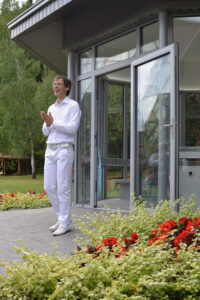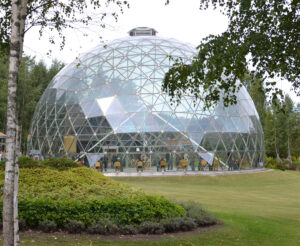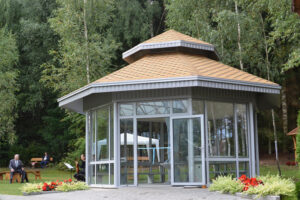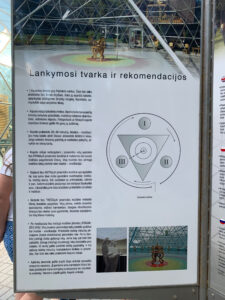PYRAMID MERKINĖ TIMELINE
1983: The founder of Pyramid of Merkinė, Povilas Žėkas, was born in Alytus, Lithuania.
1990: Žėkas received his first revelation and “signs from transcendence.”
2002: The Pyramid of Merkinė was constructed.
2003: A Roman Catholic bishop wrote a letter indicating that Pyramid of Merkinė was not connected in any way to the Roman Catholic Church.
2009: A geodesic dome was constructed that covered the Pyramid.
2010: An association to protect the Pyramid from Lithuanian state authorities was established.
2012: The organization protecting Pyramid of Merkinė won the court case against Lithuanian state authorities. The legal road sign was constructed.
2015: The Guardian Angel space opened.
2018: The statues of the prophet Elijah and archangel Michael were constructed.
2020: Liberation Hill paths and the Lighthouse of Hope were constructed.
FOUNDER/GROUP HISTORY

Povilas Žėkas (b. 1983) was raised as an only child in the southern Lithuanian city of Alytus. [Image at right] He spent much of his childhood on the homestead where the pyramid would be built with his maternal grandmother. Žėkas claimed that his grandmother was a devout person who taught him about Catholicism. The seven-year-old first heard his guardian angel’s voice on August 19, 1990, during Mass. That evening, he had a dream in which a column of light descended from heaven and landed in the midst of a meadow on his grandmother’s property. The angel described it as a special location, which Žėkas later explained was because of the energy created by the light column. As a child, Žėkas became accustomed to these kinds of conversations with his guardian angel and did not feel afraid, even when, in later revelations, he was told that these communications were actually with God.
Žėkas’ first vision in 1990 occurred when significant sociopolitical events were taking place in Lithuania. The nonviolent “Singing Revolution” was a part of the national awakening movements in Lithuania, Latvia and Estonia between 1987 and 1991. This patriotic awakening in Lithuania, which gained independence from the Soviet Union in March 1990, included a religious renewal. At this moment, Roman Catholic churches were filled with people praying for their nation, and Žėkas remembered being in a church when he first heard his guardian angel’s voice. Many people converted, returned to being Catholic, or began engaging in intense Catholic and other religious practices in the context of the religious revival. The population of believers, especially Roman Catholics, grew quickly (Žiliukaitė et al. 2016).

As the twentieth century gave way to a new millennium, the construction of the pyramid in 2002 coincided with a decade of socio-political and economic transformations, including the country’s engagement in international alliances such as NATO and the European Union. [Image at right] The Catholic Church participated in this public and political life, even while drawing boundaries to exclude those individuals and institutions that did not comply with Church teaching, including the Pyramid of Merkinė.
In the spring of 2009, seven years after the pyramid was built, Žėkas received a revelation that a glass geodesic dome should be created to cover it. Lithuanian authorities objected, claiming that such a building would be against the law in accordance with the laws governing construction in national park areas where the Žėkas homestead was built. Several thousand visitor signatures were obtained in favor of the dome’s construction, and the government opposition united supporters in the Pyramid of Merkinė community. Later that year, the geodesic dome was constructed, and the people who contributed to the project became officially recognized as a public association.
Following several court proceedings, the judge ruled that the geodesic dome might remain, temporarily resolving the conflict with the State that its construction had sparked. The pyramid was officially recognized as a place of cultural attraction in 2012 when an official road sign pointing in its direction was built on the nearby highway. This put an end to the legal battle for the pyramid’s survival.

In 2015, Žėkas opened a tiny chapel in honor of the guardian angel to fulfill the tasks outlined in his visions. [Image at right] Along with several hundred spectators, the inauguration ceremony attracted media members, whose descriptions of the Pyramid of Merkinė and its founder, which had started as soon as the pyramid was built, should not be underestimated. Reporters covering the discourse surrounding the 2012 Phenomenon (the expectation, according to a particular set of beliefs, that the world was to experience cataclysmic events on December 21 of that year) gave special attention to Žėkas’ recommendations on how to survive the apocalypse. In turn, Žėkas used the media, including websites and social networks, to disseminate his ideas and doctrines and provide information on the pyramid, including on appropriate behavior inside. He insisted, though, that experiences within the pyramid would differ according to the spiritual state of each person; hence visitors should act as they feel appropriate.
DOCTRINES/BELIEFS
A 2004 book authored by Žėkas and his mother, Onutė Žėkienė, is one of the primary written sources about his revelations, though his website offers other materials about his revelations and his answers to visitors’ questions. His mother wrote Žėkas‘ biography, hich is presented in the book’s opening section within the format of a typical hagiography in the Christian tradition. It chronicles Žėkas life and several noteworthy incidents highlighting his peculiarity or holiness. Žėkas’ mother explained that she had to look up an astronomy book to find the answers to his inquiries because she was told that he was a unique youngster who was fascinated by the stars. Žėkas grandmother continued his education by teaching him about theology as she had the patience to explain complex concepts to young children. As is the case for other religious figures’ lives, hagiographical references to childhood emphasize and legitimize the person’s uniqueness and importance, making the leader distinctive in the eyes of believers and thus contributing to the constructed charisma. By all accounts, Žėkas seems to fit these normative accounts.
The book’s second section is divided into questions and answers, with God providing the answers to the questions posed by Žėkas. Although his mother’s account of creation differs somewhat from the two biblical versions in Genesis 1 and 2, she describes the stages of revelation and the pyramid’s role in saving humanity. She also uses many common Christian terms, such as God the Father, God the Son, Trinity, angels, guardian angels, hell, and revelation. Every section concludes with, “This is the word of God,” a declaration commonly used by Catholics after reading from the Bible during the liturgy. Such connections to Christianity might be interpreted as a legitimizing strategy in a social environment dominated by Catholicism. However, it is also true that Catholicism was predominant in Žėkas’ family and social milieu. An important part of Catholicism is the Virgin Mary, and apparitional visitations by Mary during difficult times, particularly during the Soviet period, were not extraordinary. This comparison notwithstanding, it should be noted that in his teaching, Žėkas does not emphasize her as an important figure, distinguishing his perception of Roman Catholicism from the one that is commonplace among people in Lithuania.
It is difficult to systematize Žėkas’ teachings, as he claims he still receives revelations from God. Following the typology of sociologist Roy Wallis (1984:9-39), the Pyramid of Merkinė and its doctrine may be located between world-affirming and world-accommodating, in accordance with its “orientation to the world.” World-affirming religious movements emphasize human potential and offer techniques that enable people to reach their aims in life. At the Pyramid of Merkinė, visitors are invited to strengthen their spiritual health and thus help themselves in everyday life. While the practices themselves do not directly enable people to reach their goals, they might be considered as enabling people to cope with everyday stress and anxiety. World-accommodating religious movements provide inspiration for inner (spiritual) life, but they have limited implications for the way this life should be lived. Throughout its existence, the Pyramid of Merkinė has encouraged interior life, and its loosely structured community and vague relations with visitors, including those who possibly have had experiences within the pyramid, place it closer to Wallis’ world-accommodating type of religious movement.
Two important aspects of Žėkas’ theology are the location of God and the perception of the end times. He explains that God is inside each person, and everyone can obtain a relationship with Him. At the end of time, souls will travel to one entity (God), reconnecting every soul to the Spirit. The Spirit will join the Lord of the Solar System (the Lord Christ), who will join the Lord of the Galaxy, who in turn will join the God of the World (who communicates with Žėkas), who will reunite with the God of Universe, who in turn will join God the Father.
In 2011, Žėkas’ dialogue with God was published on the Pyramid of Merkinė website (n.d.), followed by a text on virtues and vices with practical applications of teachings for everyday life. Žėkas asked God about Christian virtues and vices, and his answers clarified which actions ought to be regarded as wicked or would be affected by the operation of karma. Some of the teachings promoted monogamy, monogamous partnerships, and increased social awareness of homosexuality, none of which are obstacles to spiritual development. The essay condemns pedophilia as a sin and “societal illness,” while incest, homicide, alcoholism, drugs, and family violence should be opposed because they harm the soul. In general, Žėkas addresses sensitive issues also addressed by the Catholic Church, particularly with respect to sexuality and family life. His approach is more moderate and does not emphasize celibacy, stressing that family life does not impede spiritual development, and that there is no need for monasticism or clerical celibacy.
RITUALS/PRACTICES
The rituals and practices of the Pyramid of Merkinė phenomenon continue to develop as new revelations are received by its founder Povilas Žėkas, and additions to the place are made following these.
While pyramids believed to have spiritual powers are frequently square-based (and in Žėkas’ vision God the Father told him that the pyramid in Lithuania was a divine place with the power to heal both spiritually and physically), the Pyramid of Merkinė is triangle-based with triangular sides. It is constructed of aluminum, with two crosses made of a secret metal alloy, according to the information given to Žėkas during his revelations. According to Žėkas’ mother, this revelation caused difficulty because it meant that contractors could not use more readily available metals for the alloy and had to follow the revealed measurements and the angle of pyramid placement. Special attention was given to the cross inside the pyramid because, according to the revelation, it was surrounded by special sounds from nature.
The sides of the Pyramid of Merkinė are devoted to the three persons of the Trinity, and instructions in every corner explain what a visitor may feel in relation to each member of the Trinity at that spot. A holy water bottle with the purported ability to treat various ailments is located close to the wall consecrated to the Holy Spirit.

When Pyramid was erected Žėkas used to instruct the visitors about the practices in the Pyramid, how to behave in the place, to walk around the Pyramid, and stand for a while under the metal structure. As the place started attracting more and more visitors, the instructions by its founder were not sufficient; one could observe that people were following one another‘s behavior; some were taking shoes off and walking barefoot around the Pyramid, some were praying in a Catholic manner and kneeling down under the Pyramid. Later the stand was built by its owners, instructing visitors about the practices to be followed around the Pyramid. [Image at right] The Povilas Žėkas chanting in the Pyramid is yet another practice introduced, and receives quite a lot of visitors‘ attention. As the place was developed further, adding the Liberation Path in 2020, instructions were also provided for visitors on the practices in this place, too.
ORGANIZATION/LEADERSHIP
The Pyramid of Merkinė followers are attracted to the place to receive spiritual healing and, from its founding, served as a cult place with shared knowledge about it via personal networks. When the conflict with state authorities took place, there was a need for a legal entity to participate in the court case to defend the Pyramid of Merkinė. The association “Pyramid of Merkinė“ was established in 2010 and continues to exist. Politician Algimantas Norvilas leads the association, and according to official information, four people are employees in the organization. There are no membership requirements in the organization, and the followers of the Pyramid of Merkinė and its founder, Povilas Žėkas, might be identified as a network rather than an organized group, although the existing association resembles the group with shared inner knowledge about the place development and funding not available to the outside inquiry.
ISSUES/CHALLENGES
From its erection, the Pyramid of Merkinė has attracted the attention of the dominant Roman Catholic Church, which led to the official denial of the connection of the Pyramid to Catholicism issued in 2003 (Žeižienė 2003). Another challenge the Pyramid of Merkinė faced since its construction was the conflict with Lithuanian state authorities regarding the permission to construct the geodesic dome above the metal structure of the Pyramid. While the tensions with the Roman Catholic Church have continued, the relations with state authorities have eased as the place became a spiritual pilgrimage attraction and found its place among other places to be visited in Lithuania among spiritually minded people and not limited. This continuously contributes to the socioeconomic development of the region.
IMAGES**
** All images are the property of the author and are used with permission.
Image #1: Povilas Žėkas.
Image #2: Pyramid Merkinė,
Image #3: The Chapel at Pyramid Merkinė.
Image #4: Instructions for Pyramid visitors.
REFERENCES**
** Unless otherwise noted, material in this profile is drawn from Milda Ališauskienė. 2017. “Catholic Pyramid? Locating the Pyramid of Merkinė Within the Field of Religion and Beyond.” Nova Religio. Journal of Alternative and Emergent Religions 20:36-56 and Milda Ališauskienė and Massimo Introvigne. 2015. “Lithuanian occulture and the pyramid of Merkinė: innovation or continuity?” Pp. 411-440 in Handbook of Nordic New Religions, edited by James R. Lewis and Inga Bårdsen Tøllefsen. Leiden: Brill.
Pyramid of Merkinė website. n.d. Pyramid of Merkine: The Place of Spiritual Experience and Healing. Accessed from https://merkinespiramide.lt/en/homepage/ on 15 August 2023.
Wallis, Roy. 1984. The Elementary Forms of New Religious Life. London: Routledge.
Žeižienė, Elvyra. 2003. “Laiškas kunigams dėl Česukų piramidės.” XXI amžius. 2003-05-02 d. Accessed from https://www.xxiamzius.lt/archyvas/xxiamzius/20030502/orae_03.html on 23 August 2023.
Žiliukaitė, Rūta, Arūnas Poviliūnas and Aida Savicka. 2016. Lietuvos visuomenės vertybių kaita per dvidešimt nepriklausomybės metų. Vilnius: Vilniaus Universiteto Leidykla.
Publication Date:
25 August 2023
